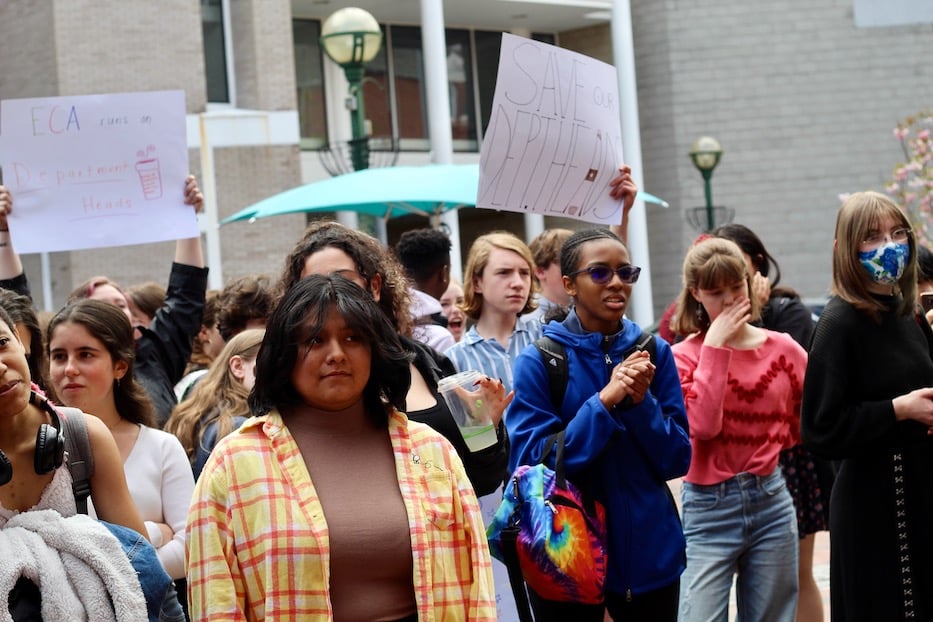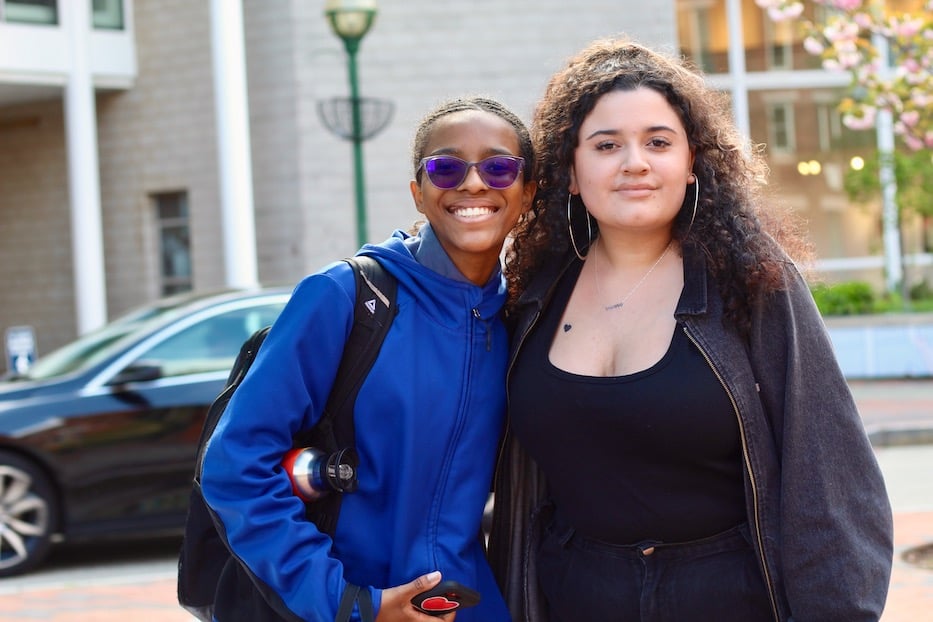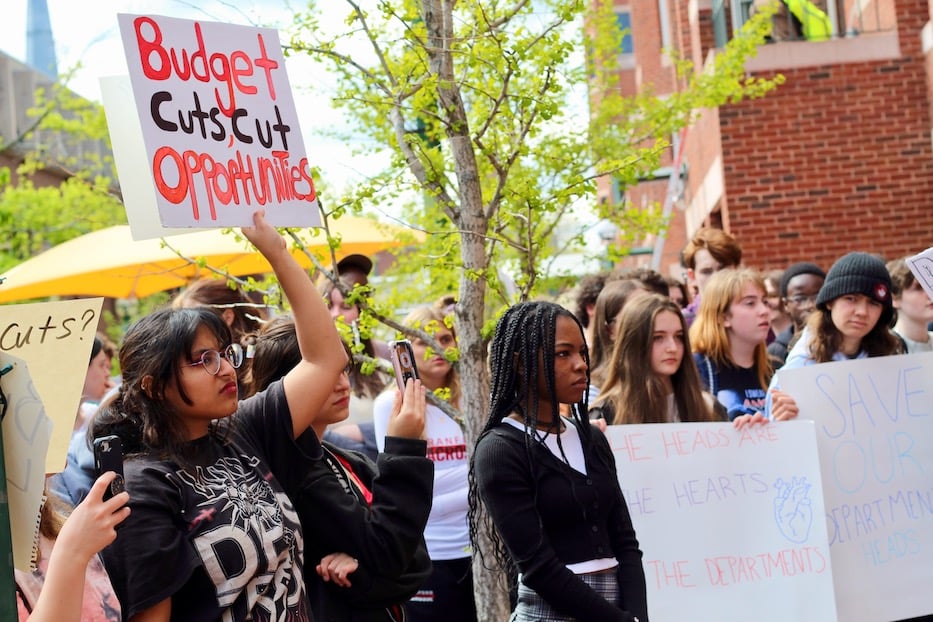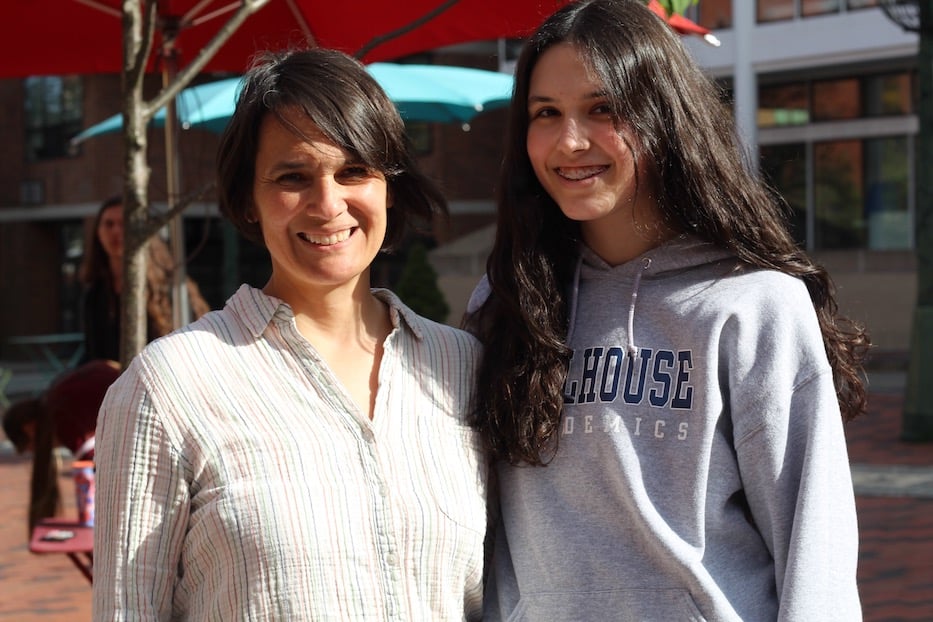
Culture & Community | Education & Youth | Educational Center for the Arts | Arts & Culture

Javy Arias, Gabby, and Isling Morris. Lucy Gellman Photos.
A screenwriting class at the Educational Center for the Arts (ECA) saved Isling Morris’ life. So when they heard that their department chair might not have a full-time, benefitted job to come back to in the fall, they started organizing. Not just for him—but also for four of his colleagues who were in the same boat.
Now, they have an arts army of students, parents, former faculty members and alumni behind them. Will it be enough to save five full-time jobs that are on the line?
Monday, Morris joined over 100 of their peers to ask that question, as students walked out to protest budget cuts at the long-beloved Audubon Street arts magnet school. Speaking one after the other to eardrum-shattering cheers, young artists urged the administration to reconsider the proposed cuts, which will eliminate full-time department chairs in dance, theater, music, creative writing, and visual arts.
Those faculty members have the option of staying on part time, but will lose their health benefits. They have until April 27 to respond to the agreement with the Area Cooperative Educational Services (ACES) teachers’ union. More on that below.

The proposed cuts come from ACES, the parent agency for ECA, amidst shrinking enrollment and budget woes at the school. Since 2018, ECA has gone from 319 students to 266. The school will also be bringing on a new principal, Kevin Buno, in the fall of 2023. On April 5 of this year, the board of ACES voted to approve a smaller budget, but did not communicate that to parents at the time.
“Department heads are expensive for a reason,” Morris said in a Zoom interview Saturday, as they organized plans for the student walkout. “They do so much work. They have done so much for so long. These people are in it. They're like, ride or die. The fact that they are being viewed as replaceable or cuttable is honestly shocking.”
The cuts, which follow a study from Odyssey Associates and became public last Friday morning, propose dissolving ECA’s full-time (0.8 full-time equivalent, or FTE) department chairs in dance, theater, creative writing, music and visual arts as a cost-saving measure. Under this new model, all five departments would fall under the leadership of a single vice principal at the school.
Meanwhile, current full-time faculty are invited to stay on in a part-time capacity (0.5 FTE), but would no longer have their titles, their same salaries, or access to health benefits. Some of them are the primary health care providers for their families.

Gretchen GG and Ryan Knapp. Gretchen is a freshman in visual arts and Ryan is a freshman in theater.
Department chairs include Saul Fussiner in Creative Writing, Amy Christman in Music, Johanna (Hanni) Bresnick in Visual Arts, Mariane Banar-Fountain in Dance, and Ingrid Schaeffer in Theater. In their current roles, they are responsible for designing and implementing the curriculum, hiring part-time faculty and teaching artists, supervising and advising students, and managing the budgets of their respective departments.
Reached by phone and email, three of the five declined to comment.
The proposed cuts result in a net savings of $142,750 per year, according to ACES Executive Director Thomas Danehy. In an email Monday afternoon, Danehy said that the five department heads currently cost the school $528,089 for the 2022-2023 academic year. Reducing them from full- to part-time staff members, through which they would lose their health benefits, will be $219,508 per annum, he said. A new vice principal, meanwhile, will cost $165,831 in the next school year.
Danehy added that part-time staff will also be taking a pay cut: “The approved budget also has reductions of $89,150 for part-time instructors.”
The cuts come less than a full year after ACES purchased a two-story building at 388 Orange St. for $975,000. So far, no classes are being taught in that building; its previous owners are currently leasing it through August of this year.
“Here, You Don’t Feel Like A Minority”

Theater students Erin Palmer and Viviana Rodriguez. Rodriguez, who attends North Haven High School before getting to ECA at 1 p.m., started a petition to save the department chairs' full-time positions.
Monday, students gathered outside the school’s sliding doors on Audubon Street, carrying handmade signs that declared “S.O.S. Save Our Staff!,” “Budget Cuts Cut Opportunities” and “I’m Not Mad, Just Disappointed” among other slogans. For over an hour, close to a dozen of them spoke about the ways in which the school, and specifically its department heads, have supported them as young artists when they don’t always know where else to turn.
As they did, a handful of parent advocates and alumni cheered them on from nearby patio furniture that had been set out on the street. A few representatives of Long Wharf Theatre and Creative Arts Workshop trickled out of their offices to watch.
Students noted that ECA has a model unlike any other school in the state. During the first half of the day, high schoolers from 24 regional districts attend their “sending schools,” or the public schools in the cities and towns that they are from. Then from 1 p.m. to 4 p.m., they come to ECA for three hours of arts education, taught by professionals in the field.
All department heads are also certified educators. In New Haven, the only eligible sending schools are Wilbur Cross High School and James Hillhouse High School.

“I was just so beaten down,” she said. “And then I would get to Saul’s class. And he would bring energy and passion and excitement that I hadn’t felt in any of my sending school classes."
Junior Naomi Borenstein, one of Monday’s organizers who is studying creative writing, remembered starting high school in the midst of the Covid-19 pandemic, when it felt like the entire world had been flipped on its head. As a student at North Haven High School, she trudged through her virtual classes each day just to get to 1 p.m.
It was emotionally and mentally exhausting, she said. And then there was Fussiner, waiting at 1 p.m. to make her day that much better, even if the classroom was just a two-dimensional screen.
“I was just so beaten down,” she said. “And then I would get to Saul’s class. And he would bring energy and passion and excitement that I hadn’t felt in any of my sending school classes. He brought so much enthusiasm, even if all of the screens had their cameras off. Even if no one was commenting on workshop. He kept on trying to make the community a community, even in a time like that.”
For Borenstein—and with so many of her peers—Fussiner became so much more than an instructor. He was and is a tough but empathetic critic, a thoughtful advisor, and an educator who was willing to read and workshop drafts well beyond school hours. When Borenstein’s cat died her sophomore year, Fussiner checked in on her after getting a message that she would be absent from class. She was floored. That sense of community has carried her through, she said.
“Stuff like that really shows you how much these people care about us,” she said. “We’re not just students to them. We’re people. I also have friends who feel that Saul created this very accepting community for us … a lot of people here feel that this school is a safe haven from our sending schools.”
While she is sure that Buno is highly qualified, she added, she does not think he’s capable of replacing five people across five different disciplines. Instead of moving the positions to part-time, she proposed fundraising efforts at the school that will let the department chairs keep their positions and create a more financially stable school going forward.

Gabby before the walkout.
For other students, ECA is the place that makes high school bearable. Freshman Gabby (he asked to use only their first name), who is studying visual arts, remembered feeling scared to express himself fully before getting to ECA. But when he stepped into the visual arts department, people could come as they were.
Before speaking Monday, he carefully put together an outfit that included ripped black stockings, short shorts, furry pink wristbands and a matching necklace, heavy eye shadow and a turmeric-colored beanie. “The school has made me so much more confident in my being,” he said. He later praised teacher Hanni Bresnick as “a boss, a beast.”
“Who here loves ECA?!” Gabby said to screams that made it feel more like a rock concert than a walkout. “If it wasn’t for ECA, I wouldn’t be dressed the way I am. I wouldn’t be expressing myself the way I am. I wouldn’t be as confident as I am today. And I think one of the reasons why is … we have such a great community that is fueled by our teachers.”

Gwen Braithwaite, Amaya Dubey, and Ollie Higgins. Braithwaite, a junior who transferred into ECA this year and is studying creative writing, said she is also skeptical that an assistant principal can possible match the work of five department heads.
Viviana Rodriguez, who is a sophomore in the theater department, said she can’t imagine making it through high school without ECA. Each day, she begins classes at North Haven High School, where she feels out of place as one of the only non-white kids. Then she comes to ECA. As she described Ingrid Schaeffer’s classroom, her eyes lit up.
When she heard about restructuring through one of her teachers, she started a petition to try to stop it. By Monday night, it had nearly 1,300 signatures. She slammed ACES administrators for placing in danger not only staff positions, but students’ sense of belonging and safety.
“It is difficult,” she said, striking a power stance in an all-black ensemble. “It’s difficult to be in a town that limits the ability of young people in the arts, and in a sending school that is predominately white. Here, you don’t feel like a minority.”

Solace Khuc, a junior from the visual arts department, was originally hesitant to speak (“wait, how loud is loud?” they said as they lifted themselves onto a low brick ledge that became a stage). Then they remembered the hours that Bresnick, a 20-year veteran who took over the department from her mom, put into portfolio reviews, student art shows and one-on-one feedback.
To cries of “Yes Solace!” and “You got this Solace!,” they called for more transparent communication from ACES administrators, who have left students, parents, and faculty members scrambling for answers at the 11th hour. They pointed to the timeline of finding out about the changes Friday, and watching parents and students snap into action over the weekend.
“Some of us have bonds closer than any we have known before, all because community holds this school together,” they said. “This is thanks to the wonderful teachers here. Without them, this would never happen.”
Those words echoed later, as a fellow student remembered Bresnick paying for supplies out of pocket after the department ran out mid-semester. They echoed as Amaya Dubey, a junior studying visual arts, noted the rarity of finding a place where students are willing to spend an extra three hours to be in school “just to learn about art.”
They echoed when Arthur, a student from the creative writing department, praised the fellow “weirdos” at ECA for helping them survive high school.
“I know I’m not the only kid that survived shitty people at their sending school because of this place,” they said. The crowd went wild.

Amaya Dubey is holding the sign that reads "Budget Cuts Cut Opportunities."
Senior Gabriel Cirdan Armstrong, who is in the visual arts, pointed to the sheer amount of work that goes into each department. In visual arts, that includes “Portfolio Day,” during which seniors spend a day talking about their work with representatives of schools from across the country. In past years, Armstrong said, it has resulted in college admission and full and partial scholarships for students who might not otherwise attend college.
“Those cannot come together without the help of Hanni, the department head,” he said. “She oversees every one of these things. It’s bonkers! I don’t know how she does it. But she puts them together … and people’s futures have gotten set up because of these interviews.”
“Maybe out of the goodness of their hearts, they will be willing to try their best to keep up some semblance of these transitions,” they added. “But I wouldn’t do that, on the budget of a normal teacher. I would barely do that on the budget they’re already getting as department heads.”

Senior Phoenix Geyser, sophomore Emmy Rosario, and sophomore Oren Mendieta.
Fellow senior Phoenix Geyser added that for her, ECA has been the bridge between deep social anxiety and a college education that is now entirely within reach. When Geyser started at ECA, she was coming out of the haze of Covid-induced isolation, homeschooling, and post-concussive syndrome, which is a type of mild brain injury.
“I was injured, I was shy, and I didn’t have many people who believed in me,” she said. Then she met Christman. The department head advocated for her. She figured out how to make the curriculum work for Geyser, who experienced anxiety being around other people. Over four years, she nurtured Geyser as a musician and as a young adult, making sure there were opportunities for her to fly. She is now headed to the Boston Conservatory in the fall.
“If Amy wasn’t here, I wouldn’t be here either,” she said. “I hope ACES can reconsider the changes they have because it will change ECA in a devastating way.”
“Could You Please Explain What Is Happening?”

It follows a dizzying three days for the ECA community, which has become a safe haven for students across the state and sometimes a home for generations of artists who have attended and taught at the school. Even as students walked out Monday, parents and alumni were still writing frantic emails and making calls to ACES administrators, begging them to reconsider.
Parents first became aware of the changes last Friday morning, after Danehy posted a message to Parent Square, an internal school messaging platform, announcing the restructuring. In the message, he explained that ACES had brought on Odyssey Associates to study the school. Odyssey's founder and principal, Joshua Borenstein, is an ECA parent.
Since 2018, enrollment at ECA has been shrinking, he said. In part, that is due to the state’s decision to cut Connecticut State Department of Education funding for dual-enrollment programs in magnet schools. In New Haven, for instance, students at New Haven Academy or High School in the Community can no longer attend ECA for classes in the afternoon.
Among other findings that contributed to the restructuring, he cited parent and student satisfaction, lower enrollment and a “large, unsustainable financial deficit to ACES” as the most pressing. In later communications, he said that the deficit is “in the range of $500,000.” Danehy also said that he had not yet seen the full report, and that he intends to share it with the ECA parent community when it becomes available.
Odyssey’s Borenstein declined to share or comment on the report on the basis of a confidentiality clause in the project. Neither ECA Principal Leslie Abbatiello nor Director of Curriculum and Instruction William Rice, who were Borenstein’s primary contacts at the school, responded to a request for comment.
By mid-morning Friday, parents were calling each other trying to sort out the news, several told the Arts Paper. Among them, Djuna Clark, co-president of Parents for Arts Centered Education (PACE), wrote to Danehy asking for more clarity around the changes. She noted that parents had been totally blindsided by the message. She later added that she, along with other members of PACE, worries about the quality of education at the school under the proposed restructuring.
“Could you please explain what is happening?” she wrote Friday. “Why? Will you consider engaging parents in this major decision for such a longstanding institution?”
In an email to the Arts Paper Monday afternoon, Danehy sought to assuage concerns that the restructuring would affect curriculum. He did not address a specific question from the Arts Paper on how one vice principal will be able to cover the administrative workload of all five positions.
“There are several prevailing forces that ACES Leadership must consider ensuring the viability of ECA over the next 50 years,” he wrote, “In considering the options, ACES believes that a new configuration is needed so that the new path forwards supports diverse, new and innovative programming, increased opportunities for inter and cross disciplinary programming, improved recruitment results for higher enrollments, and field internship opportunities.
“ACES leadership has considered several variables and we will consider additional input but ultimately we need to look far and wide on multiple pain points and impacts before making a decision that is best for current and future students of ECA.”
“The Students Will Suffer”

Mom Kimberly Garley-Erb with her daughter, Madeleine.
In a number of phone calls and interviews Sunday and Monday, parents, former faculty members and ECA alumni all expressed their frustration at the situation, from the lack of communication to their fear that the restructuring will fundamentally change the fabric of the school.
Kitty Clemens, an ECA parent whose son is in the music department, said that she’s worried by the lack of transparency from ACES administrators. When her son, William O'Shea, was starting high school, they chose Wilbur Cross specifically so he could go to ECA.
Under Christman’s watchful eye, he has flourished as a musician, branching out from guitar to composition, production and performances with his band. “If ECA becomes something different, I don't know what we'll do,” she said.
A former faculty member, who requested that her name and department remain anonymous, pointed to the sense of belonging that all five department chairs have been able to cultivate across the school for decades. ECA, where students are often doing work that is “really at the graduate level,” is one of the only places where she has seen teachers push students to experiment, to take risks, and to fail as a way to learn.
“Many many of my former students are heads and tails above their colleagues when they get to college,” she said. She can’t imagine a single person having the same impact as five department heads.
“I think my concern is that the students will ultimately suffer,” she said. “It's the department chairs who determine the scope and sequence of the curriculum. They know each student very deeply and set their trajectory through the curriculum … There's probably more than 100 years of collective experience between them. They know the school the best. they've witnessed the changing needs of the cultural landscape.”
Kimberly Garley-Erb, whose daughter Madeleine is a sophomore at Hillhouse and in the visual arts department at ECA, called the school “essential to her high school experience.” Since Friday, Garley-Erb has been racing the clock, urging other parents to get involved. Monday, Madeleine also praised “the sense of community” she’s been able to find and cultivate at the school.
“For her [Madeleine], ECA is a place where she is able to connect with her passions,” Kimberly Garley-Erb said. “It goes well beyond being an artist. It’s being a critical thinker and a citizen of the world.”
ECA alum Tagan Engel, who attended the school for dance, said the school was part of what brought her back to New Haven after she became a mom. Two decades ago, Engel entered ECA’s dance department, and was able to grow her understanding of the art form into a craft that she pursued in college. When she and her peers pushed the envelope, she remembered—a request for African dance lessons, for instance—ECA rose to meet their questions every time.
“Being a dancer and growing up in a public school, artistic community was extremely important to the creativity I have been able to foster though all of my life,” she said. “Whatever I am doing, I approach it as an artist. ECA gave me creativity, outside the box thinking, community building skills. It was so foundational and so nourishing for me as a young person.”
Watch more from the walkout in the video above.

